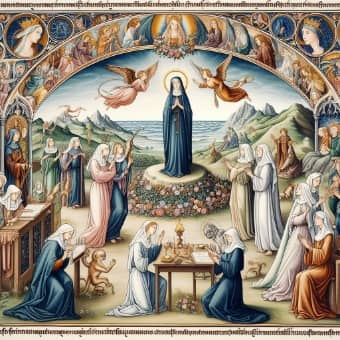Exploring the Life and Legacy of Saint Hildegard of Bingen
Visionary, Composer, and Saint
Saint Hildegard of Bingen was a remarkable figure of the Middle Ages, whose contributions extended far beyond what might have been expected from a 12th-century German Benedictine abbess.
Her multi-faceted legacy as a composer, theologian, writer, and mystic has continued to captivate scholars, spiritual seekers, and lovers of music and holistic medicine throughout the centuries.
In this blog post, we’ll delve into the extraordinary life of Saint Hildegard and explore how her work and visions continue to inspire people around the world to this day.
This blog post contains affiliate links. When you click on a link on this page and make a purchase I may earn a small commission, at no additional cost to you. Thank you for your support.
Early Life and Spiritual Visions
Born in 1098 in Bermersheim vor der Höhe, into a noble family, Hildegard was the tenth child and, as was the custom for a tithe, dedicated to the church. From an early age, she experienced visions that she believed were divinely inspired.
At the age of eight, she was placed in the care of an anchoress named Jutta, at the Benedictine monastery of St. Disibod in Disibodenberg. It was there that she learned to read and write, performed monastic duties, and developed her knowledge of the Latin and the Scriptures.
Hildegard’s spiritual visions continued throughout her life. When she was 42, she felt a divine command to write down these experiences. These were eventually compiled in her major work “Scivias” (Know the Ways), which comprises of 26 visions covering a wide range of theological topics, from creation and redemption to the church and the end times.

Contributions to Music and Literature
Hildegard’s contributions to music were groundbreaking. She composed over 70 chants and hymns, many of which were collected in the “Symphonia armonie celestium revelationum”. Her music was characterized by its soaring melodies and often complex arrangements, which were unusual for her time.
Hildegard’s compositions, along with her innovative musical play “Ordo Virtutum” (Play of the Virtues), provide the earliest known examples of a morality play set to music, predating the liturgical drama of the late medieval period.
In addition to her musical works, Saint Hildegard was a prolific writer. Her texts included scientific works on natural history and medicinal treatments, found in “Physica” and “Causae et Curae”, which reflected her deep interest in the healing properties of the natural world.
Her theological texts further established her as a significant voice in the church, providing guidance on ecclesiastical and moral issues, and her correspondences with popes, emperors, and other influential figures of her day showed the respect she commanded.
Visionary of the Natural World and Healing
Hildegard’s understanding of the natural world was infused with her spirituality. She saw the interconnectedness of all living things and believed in the healing power of plants, animals, and the elements.
Her holistic approach to health and medicine was remarkably advanced for her time, often emphasizing the need for a balance between the physical and spiritual for overall well-being.
Legacy and Canonization
Saint Hildegard’s impact has continued well into the modern era, with an increasing interest in her works from various fields. In 2012, she was formally canonized by Pope Benedict XVI, and she was also named a Doctor of the Church, a title given to saints recognized as having made significant contributions to theology through their scholarly endeavors.
With her canonization, Hildegard’s life and works have garnered renewed attention, shedding light on the profound depth of her vision and intellect. Her holistic insights into the connection between body, mind, and spirit continue to resonate with contemporary audiences, providing inspiration for those interested in integrating the spiritual and the scientific.
As we revisit the life of Saint Hildegard of Bingen, we are reminded of the extraordinary impact one visionary woman had on the realms of spirituality, music, science, and healing. Her life’s work stands as a testament to the power of intellectual curiosity, spiritual devotion, and the courage to forge a path in defiance of the conventional boundaries of her time.
Saint Hildegard remains an influential figure, and her legacy endures, as compelling today as it was nearly a millennium ago.
